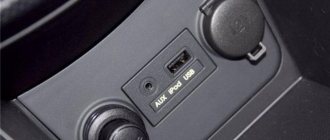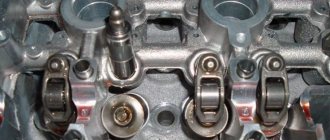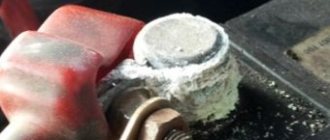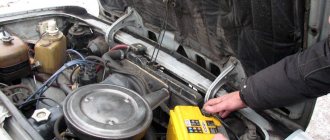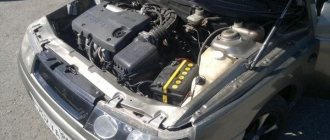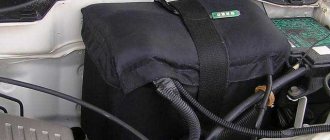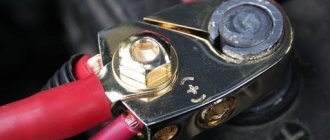Temperatures beyond 20 degrees are harmful to the battery - either too low or too high. 20 degrees Celsius is the range in which the minimum self-discharge of the battery occurs, which is a normal physical process and not a product defect.
According to standards, batteries must be stored in the so-called. indoor conditions, therefore, they cannot be stored in cold or hot areas. Increasing the temperature to 30 degrees speeds up battery discharge twice!
An increase of another 10 degrees Celsius is expected to double the effect again.
Why does the car battery discharge at night?
It would seem that while parking or parking, the car battery should hold a charge, because all devices in the car that are powered by energy are essentially turned off. But, nevertheless, at some point the car stops starting. And no matter how much you turn the key in the ignition switch, you hear a dull, indistinct click in response. This usually indicates that the battery in the car is almost completely discharged, and the remaining charge is only enough to dim the interior lighting.
And it’s good if the driver encounters this problem in a busy place - he can always call for help from other motorists who will help “light” the dead battery and start the car. But according to the law of meanness, many troubles await drivers on the road and, as a rule, far from cities and busy highways.
And there are often cases when a driver leaves his car in a parking lot overnight and in the morning discovers that the battery in it is discharged. This can happen primarily due to a faulty generator, because it is responsible for charging the battery.
See also: When to change drive belts
However, it is not always the generator that is to blame for all the troubles of motorists; it happens differently. If everything is fine with it (the generator), but in the morning the battery barely shows signs of life, although yesterday it was working and charging everything properly, then this may mean that a current leak has occurred or is occurring somewhere. In other words, to put it simply, some devices in the car are parasitic on the battery.
How to prevent battery drain?
In order to prevent the car battery from dying out overnight, it needs to be given attention and periodic maintenance.
What should you pay attention to?
- Periodically (at least once every 6 months), the battery needs to be recharged from a network charger. Ideally, you need to do a control training cycle;
- You need to develop the habit of checking the level and density of the electrolyte (after recharging the battery). This does not apply to maintenance free car batteries (link here);
- Keep the electrical wiring, generator, and consumers of the vehicle's on-board network in good condition. Very often, due to leakage current, the battery quickly runs out;
- Prevent corrosion of battery terminals and terminals (cleaning, applying a special composition);
- Keep the battery clean to minimize self-discharge. If there is dirt on the surface, it turns into a conductive layer and the battery can quickly drain.
If your car battery drains quickly, then traveling becomes a real pain. In the link above you can read about the reasons for this and how to fix them.
Thorough vehicle check
Many cars these days are equipped with an on-board computer. Naturally, it also consumes energy during the very period of time when there is no one in the car and it is parked. However, it (the computer) requires very little current - 50 milliamps per hour is enough for it, although there are also on-board computers that consume even less energy. In order not to get lost in guesswork, each motorist can personally open the on-board computer service manual and see in it exactly how many milliamps per hour it consumes. But no matter how it is, this device is not capable of discharging the battery in a car on its own.
The engine will not start: How to find out the cause of the problem
A multimeter will help you find other devices that are responsible for current leakage in the car. It is quite inexpensive, somewhere around 20 US dollars. But before measuring the amount of current consumed by devices, it is necessary to fully charge the battery. Then you need to turn off all devices and close all doors in the car tightly. After all this, you need to open one door in the car on the driver's side. In some car models, when this action is performed, the fuel pump immediately turns on, which immediately injects fuel into the engine so that it starts up faster. This process consumes more than 100 milliamps of current.
Energy-intensive cables connected directly to the cigarette lighter can also consume current. As a rule, these are chargers from a mobile phone, from a tablet, from a GPS navigator, etc. devices Even if they are completely disconnected from such a cable, the plugs in them still continue to consume a small amount of milliamps of current. At the same time, some cars have a stereo amplifier in the trunk itself, which is also recommended to be turned off for a while. It is necessary to pull out the fuses themselves in the machine block.
True, one of the points worth considering here is that some on-board computers and anti-theft systems require entering a special code after a forced shutdown. This is usually indicated in the user manual. But, if it is not there, then the driver will have to contact an official dealer. So, friends, remember, before removing the fuses from the block, which are directly responsible for the operation of these systems, you need to find out the special code in advance, if of course there is one.
But to truly get to the bottom of the root causes of current leakage, you will have to take some measurements with an ammeter on the highest range. It should reach 10 or 20 amperes per hour. However, you should not start the engine or turn on the car's headlights, as they can confuse you due to the fact that they consume a large amount of rated power. If the ammeter does not detect any leaks, then you should reduce this range to 2 amperes or 200 milliamps per hour. There shouldn't be any misfires here anymore. The ammeter will definitely record (“catch”) those devices that “steal” current from the machine. At the same time, friends, you should not rush to final conclusions. For example, the same alarm or automatic brightness control system continues to consume energy for 20 minutes after it is turned off, so be patient and wait.
See also: Is dash cam evidence?
And so, you managed to find out how much current the battery consumes at the very time when the car is parked. Now all you have to do is identify the very devices that cause its leakage. To do this, you need, again, to start pulling out the fuses one by one. Just don’t rush, friends, and remember exactly the nests on which they stick out (are located), so as not to get confused later when returning them to their original place.
Finally, you managed to identify those main devices that “steal” current from the battery. But the verification is not over yet. It is possible and most likely that there are many different reasons for battery discharge. Individually they are completely harmless, but taken together they can completely “kill” the battery.
To identify these minor causes, you will need to create a small electrical circuit and connect additional batteries to the car’s battery. In this case, it is necessary to maintain continuity through the jumpers so that the clamp provides good charging contact. However, this is not for long, then you need to remove this fuse and use the multimeter wires, which are equipped with a terminal jumper with a fuse. You will then need to disconnect all of these devices from the circuit one at a time. Finally, you should check the meter. If the voltage in the circuit drops sharply, then it follows that you have managed to detect the problem that has arisen. This could be anything, but our experience itself suggests that it can be triggered by certain phenomena, which will be discussed below.
Reason two: the on-board charging system is faulty
The next possible reason why even a new battery quickly discharges in a car lies in the on-board charging system . In a highly simplified form, it consists of only two key elements - a generator and a relay , which “decides” when it is necessary to supply a charge to the battery. Naturally, this whole thing is connected by wires and if there is a bad contact or a break, the charging system will not work.
Unfortunately, in a garage environment, diagnosing this component of the car is quite problematic. This requires knowledge, experience and some tools. It is better to entrust the solution to this problem to a trusted automotive electrician.
How can you first understand that the on-board charging system is to blame for the rapid discharge of the battery? The first sign is the corresponding signal on the panel. As a rule, this is a red pictogram with a symbolic image of a battery. It should only light up when the ignition is on and the engine is not running. Immediately after the engine is started, this signal should go out. If it doesn’t go out, lights up constantly, or lights up periodically while driving, this indicates a malfunction of the generator or charge relay.
The second way is to measure the voltage at the battery terminals before and after starting the engine. If, for example, before the start the voltmeter showed 12.4 volts, and after – 14.5 volts, then the battery is charged. If, on the contrary, the voltage drops (or rises only a couple of tenths of a volt), the charging system is faulty (or defective).
There are no other equally simple and understandable ways to diagnose a similar problem. Only an appropriate specialist can fully check the charging system.
Reason three: increased battery self-discharge
Many people attribute this reason to the first one described here. However, there is no need to rush. First, let's briefly understand what self-discharge is and how it happens.
Self-discharge is the loss of accumulated charge by a battery without connected consumers. That is, you removed the battery from the car, just left it for a while, and after a while it discharged without any load. A small self-discharge is present in any battery - completely new, from a well-known manufacturer, and so on. However, self-discharge is insignificant. For example, a fully charged, working standard car battery can be safely left for six months, after which you can install it and start the engine.
However, self-discharge can be so large that the battery drains “itself” to zero literally overnight. Very often this is due to her general poor condition, as described above. But significant self-discharge can also be caused by external factors.
And the very first of them is the dirty surface of the battery case . As a rule, this is dust that is mixed with evaporated or leaked electrolyte. This mixture is an excellent current conductor. This means that the battery, being completely disconnected from the vehicle’s on-board network, will continue to discharge.
How to diagnose? First of all, visually . If the battery case is dusty and dirty, this deficiency must be urgently eliminated. By the way, it is highly advisable to do this regularly.
A voltmeter (multimeter) will also help identify the problem . Turn on the device to measure voltage, install one probe on the positive terminal, and move the second one along the body. If any voltage is displayed on the voltmeter, current is constantly flowing through the case (which, by the way, is made of dielectric) of your battery. That is, in essence, the battery terminals are practically shorted together.
You can wash the battery with warm water to which soda is added. Then the body is wiped dry. It is strictly prohibited to use any household detergents for this! To see if there is a result, repeat the measurements as described above. Ideally, zeros should always remain on the device.
Step-by-step search for current leaks
Step 1
First, fully charge the battery. Make sure the radio and lights are turned off. Also remove the charging plugs for your mobile phone, tablet, laptop and GPS navigator from the cigarette lighter. Be sure to remove the key from the ignition and close all doors. After this, you can use the jumpers you need for clamping. This way you will be able to save all the data, including the anti-theft code itself, in the memory of the on-board computer.
Step 2
Now you can install the ammeter device. Its meter will continuously record current leakage from the battery. If the reading on the ammeter is above 600 milliamps per hour, then this is clearly too much. To do this, you will need to disable parasitic devices.
Step 3
Check if there is a light in the glove compartment. If you find it, it is better to turn it off. It also wouldn’t hurt to check the luggage compartment - maybe the light is on there too. In other words, friends, check absolutely all light sources.
Step 4
When you have eliminated all possible causes by trial and error, the only thing left is to use a test cable that connects to the fuse box, which will help you disconnect all unnecessary loads on the circuit and determine the main device that consumes the most current in the car.
So can a generator overheat with a discharged battery?
In the end, the answer is “yes, it can.” But some conditions must be met. The fact is that the test was carried out at the beginning of spring, and it was freezing outside, so the generator had an excellent opportunity to cool. If it were a hot summer outside, the internal components of the generator would heat up significantly more, which would increase the likelihood of failure.
Car alarms
A car alarm installed outside the factory can completely discharge the battery to zero within just 2 - 3 days. So remember, friends, if there is one in the car, then do not ignore it. Check all the wires of this car alarm, follow them where they go and to which connectors they are connected. It is possible that the specialists who connected it decided to save time and took the path of least resistance, thereby violating the technology of its installation and thereby increasing the load on the battery itself. As for factory car alarms, they are considered to be of higher quality. In addition, they are installed by highly qualified specialists who will not cut corners in this regard.
Recommendations
Bearings, brushes and stator and rotor windings are also checked for opens and short circuits. It is better to entrust rewinding of the generator, if necessary, to a professional service. Assembly is carried out in reverse order.
If the battery on the VAZ 2110 injector runs out even after a short stay, then do not rush to throw it away. Cleaning contacts and disconnecting “wrong” consumers can solve this problem.
And if the charging indicator lamp also lights up, then the fault must be looked for in the generator. Keep an eye on the condition of your car and it will not let you down.
Guys, I’m tired of the problem, the battery is discharged while driving. You drive and drive and bam, it stalls. The voltage was checked under a load of 13.6. What could be wrong with the battery? VAZ 21099 engineer Maybe because of the density? The battery was discharged while driving.
Radio tape recorder
A regular radio or MP3 player is not capable of significantly discharging the battery. But various stereo music systems with many speakers and connected to each other by finger-thick wires can put a fair amount of wear and tear on the battery. Typically, when the engine is off, these stereos go into standby mode and draw only 1 to 3 milliamps of current per hour. At the same time, there are often cases when they simply “freeze” and do not go into the required standby mode, the reason for which is incorrectly set DIP switches on the amplifier itself. In such cases, they consume several hundred milliamps per hour.
Experience: battery is charged
The car is being cold started. Idle for 5-7 minutes, checking the battery voltage before starting. After starting, the voltage on the generator and the battery is measured, as well as the current generated by the generator and its temperature using a magnetic thermometer.
Voltage on a charged battery before starting the engine: 12.92 Volts.
After idling for 5 minutes, the following results were obtained:
First column: “Time”, “Battery Voltage”, “Generator Voltage”, “Generator Current” and “Generator Temperature in Celsius”.
As you can see, in the first scenario, during idle operation, the battery and generator voltages were very close, with a slight advantage in voltage for the generator.
The current strength during operation at idle speed gradually decreased over five minutes from 15.25 to 13.20 .
The generator temperature, last line, increased from 10.9 °C to 23.1 °C .
Next, travel along a 20-minute route and take repeated measurements (last rightmost column)
As you can see, the temperature rose to 42.5 °C , and the Amperes dropped to 12.9 .
The final check of the battery charge after turning off the ignition did not show any drawdown - the same 12.92 Volts remained.
"Magic" keys
Nowadays, many car models are equipped with special remote keys. As soon as the driver approaches the vehicle, the locks in the car will open automatically. All he has to do is climb into the driver's seat, put his thumb on the starter button and the engine will start. In this case, there is no need to insert the keys into the ignition switch, everything is already automated.
Such contactless keys work as follows. A special radio receiver is installed in the car; it is always looking for the signal that the key emits. As soon as he fixes it, the automatic locks are activated. But the problem is that nowadays many drivers already use such keys and therefore this radio receiver constantly works in an enhanced mode, thus trying to identify the signal it needs. Imagine, friends, how much current it can take from the battery in this mode..(?) And if the driver took and left his car for a whole week in a busy parking lot near some shopping center or in the city center! In this case, the battery is naturally completely discharged.
Car owners of hybrid cars are also unlucky in this regard. For example, the Toyota Prius model is equipped with a contactless engine starting system, which runs on a 12-volt battery. The same battery also powers the on-board computer, which in turn controls all other systems. At the same time, the starter of this Toyota Prius operates using a 280-volt traction battery, and the on-board computer itself must be activated, otherwise you simply will not be able to start the engine. Because of this very imbalance, the battery is regularly exposed to high voltage and eventually begins to discharge quickly. The only way out is to turn off this system and start the car engine the old fashioned way.
What happens to the battery during low-charge operation?
If you do not keep track of when the battery starts to work on a low charge, the battery begins to significantly reduce the starting current during the process of starting the engine or receiving other unpleasant loads in this case. The higher the load, the higher the drawdown. And the higher the probability of breakdown of certain elements of the machine’s electronics becomes. Because instead of 12V, the equipment receives 8V or 7V from a discharged battery. The drawdown should not be below 10V. The processes inside the battery itself do not show anything pleasant:
- very rapid decomposition of lead plates, if we are talking about a classic acid battery for your car, contamination of the liquid during the process of decomposition of the material;
- a serious change in the properties of the liquid itself, which is caused by the ingress of materials unusual for it into the acid, a change in the conductivity of this material in the battery;
- a decrease in the ability to accept a charge, that is, the slow and steady death of the battery due to the extremely low quality of the internal environment, the complete collapse of many elements;
- a decrease in the electrolyte level due to its banal evaporation due to changed properties, the constant need to add distilled water or acid;
- inadequate response to turning on the charger, lack of the necessary indication due to completely changed properties of all elements of the internal environment.
This can happen with an acid battery if you do not charge it on time. When the battery is already discharged, the destruction process has begun. You should not allow the battery to be deeply discharged in this situation. This is a very unpleasant moment, which simply disables an expensive element of your car. So checking and recharging the battery is simply necessary. Especially if the car is mostly used in the city.


